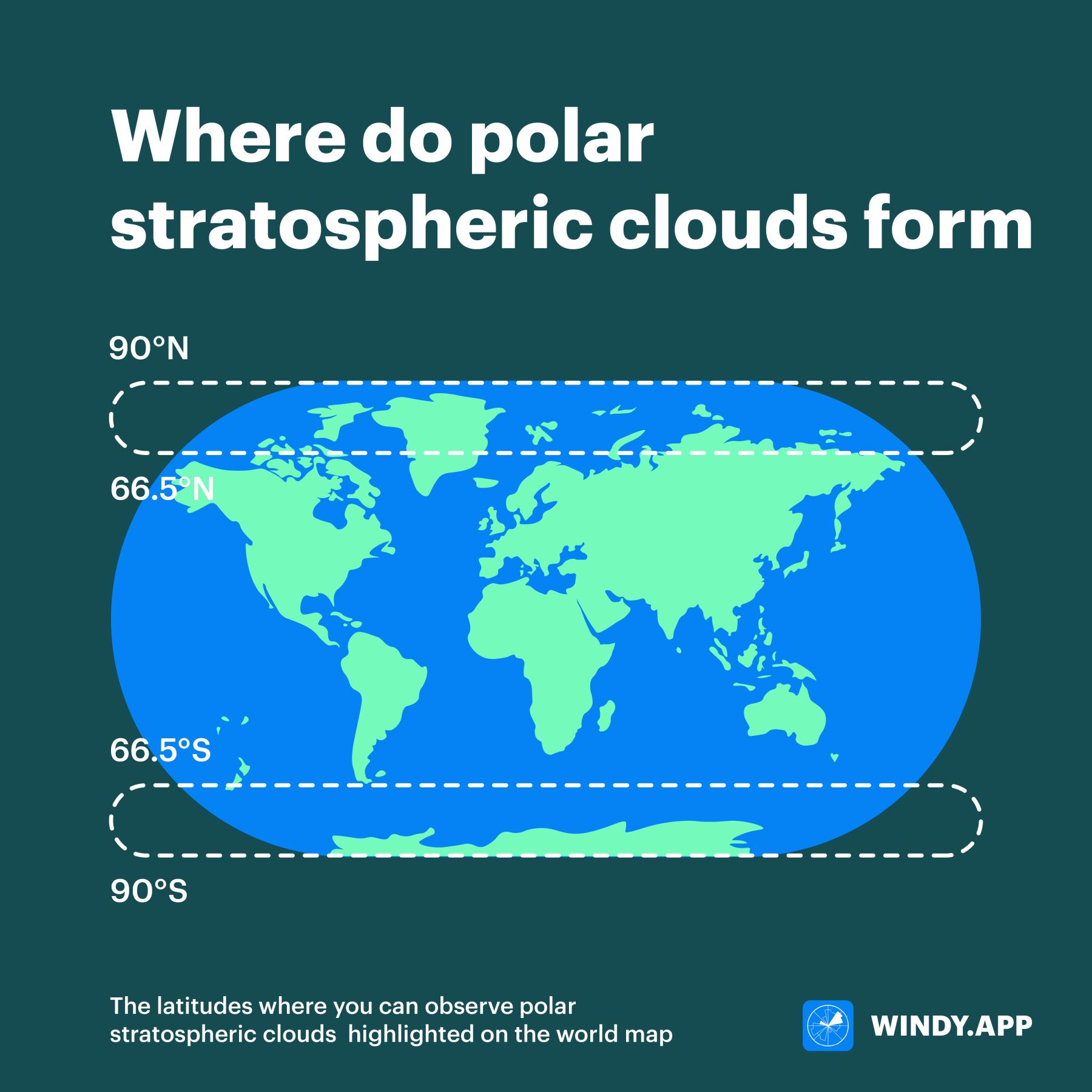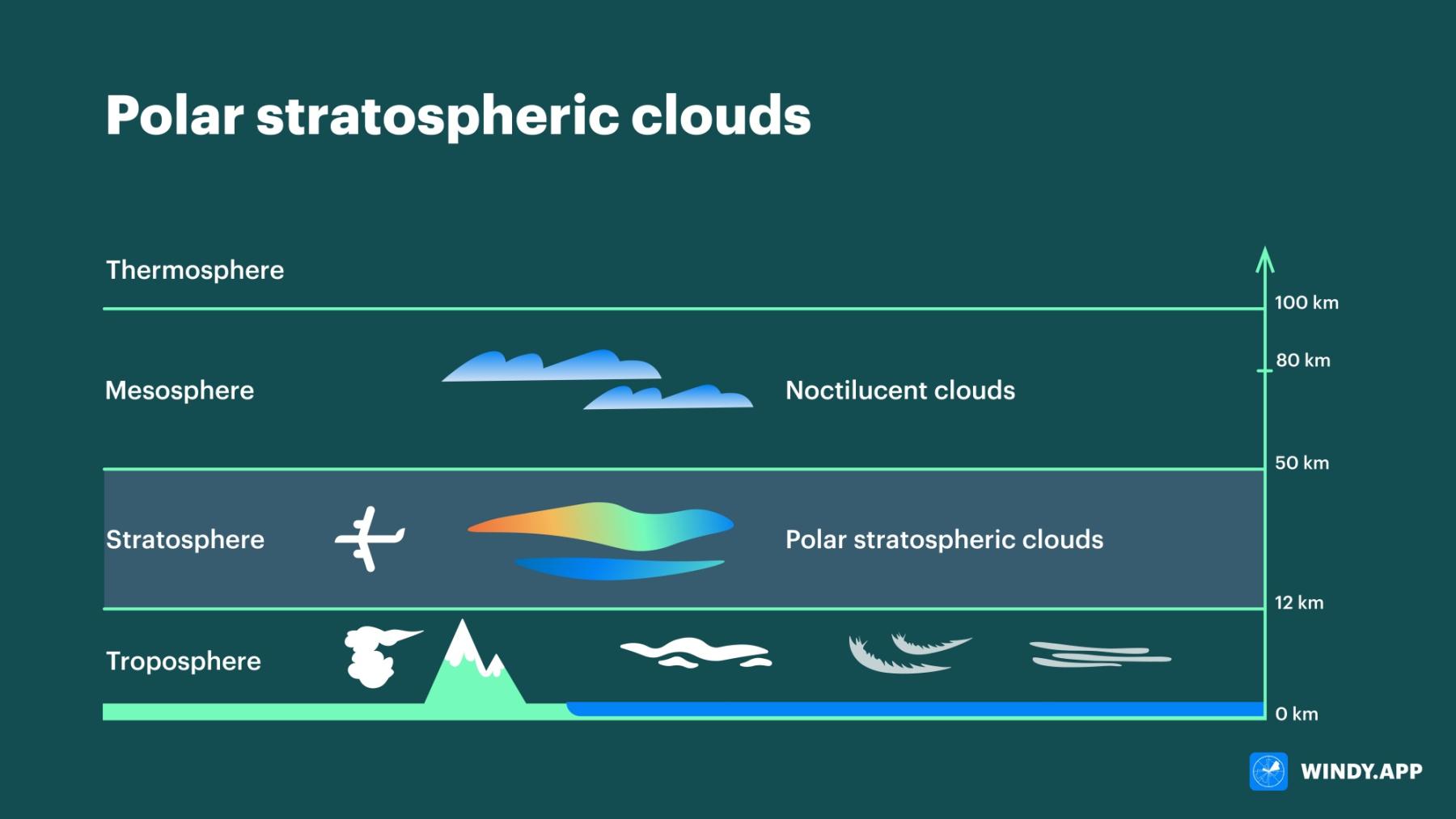
What does Edward Munch have to do with Polar stratospheric clouds
Polar stratospheric clouds also called nacreous clouds because of their unusual color are form at Polar latitudes. This is an extremely rare phenomenon! In this new lesson of the Windy.app Meteorological Textbook (WMT) and newsletter for better weather forecasting you will learn more about Polar stratospheric clouds.
Where do polar stratospheric clouds form?
Polar stratospheric clouds form in the lower stratosphere at an altitude of 15–25 km behind the Polar circle, i.e. north of 66.5°N and south of 66.5°S. at anomalously low temperatures of −78.1 degrees Celsius.
This is an extremely rare phenomenon! People in northern Europe, Greenland, Russia, Canada and the U.S. have the highest chances to see PSC. And those who come to Antarctica. Although such clouds are sometimes observed in lower latitudes.

Where do polar stratospheric clouds form. Illustration: Valerya Milovanova / Windy.app
When to observe Polar stratospheric clouds?
The best time to observe PSC is right after sunset or right before sunrise — at early dusk. At this time (within 20 minutes after sunset and 20 minutes before sunrise) the Sun is 1-6° below the horizon and illuminates clouds in the stratosphere. Lower tropospheric clouds at this time of day are in the shadows and can be seen as dark silhouettes against the background of dawn.

Polar stratospheric clouds height. Illustration: Valerya Milovanova / Windy.app
The lowest layer of the atmosphere is the troposphere. The stratosphere is the second layer from the surface, located at an altitude of about 10-50 km. On the altitude scale PSC are circled with a red line. Noctilucent clouds are marked in blue.
For PSC to form you need an abnormally low (even for the lower stratosphere!) temperature: not higher than −78 ° C or 195 K.
Such conditions are achieved very rarely and only in the winter-spring period. Therefore, PSC only appear in the cold season, unlike noctilucent clouds, which are observed in summer.
How exactly Polar stratospheric clouds form?
The first type is pale and blurred clouds
.png)
Sometimes PSC look pale and blurry — this is their first type. Such clouds consist of subcooled droplets of nitric and sulfuric acid and water, i.e. liquid particles.
Let’ see how these clouds appear. First, where do the nitric and sulfuric acid and water come from?
- Nitric acid is derived from nitrogen, which is 78% of the atmosphere. This acid is formed during thunderstorms, when lightning strikes. Right in the lightning channel (where there is a discharge), at extremely high temperatures, nitrogen reacts with oxygen and then reacts with water. The result is nitric acid in a gaseous state, as gases are involved in all reactions. Nitric acid vapor enters the stratosphere with air mixing, which always takes place in the atmosphere one way or another.
- Sulfuric acid can be formed directly in the stratosphere. In strong volcanic eruptions, gaseous sulfur compounds are pushed into the stratosphere, from which liquid sulfuric acid is then formed. Volcanic activity creates additional conditions for PSC to appear in the sky.
- And, finally, water. In the stratosphere, there’s a thousand times less water vapor than in the troposphere. However, there are various mechanisms through which the necessary amount of moisture gets there. One very interesting mechanism is that at heights of 120-200 km, in the thermosphere, self-ignition and combustion of hydrogen occurs. During combustion, i.e. in the process of combining hydrogen (2H2) with oxygen (O2), water vapor (2H2O) is formed. Water vapor is heavier than hydrogen, it descends due to gravity and enters the stratosphere.
How do all these components become a cloud?
Any cloud is liquid or solid particles, and often both at the same time. A cloud appears if a gas turns into a liquid or solid substance, i.e. condensation occurs.
The smallest gas particles have to combine to form larger droplets, but gas molecules themselves are not attracted to each other. Condensation in the atmosphere occurs because there are various liquid and solid particles in the air, such as sea salt or dust. These particles serve as magnets for gas molecules, so to speak. They attract and retain gas molecules, and they combine in droplets. These solid and liquid particles are called condensation nuclei.
We have already seen what is present in the stratosphere:
- liquid sulfuric acid
- gaseous water
- gaseous nitric acid
You may have already guessed that condensation nuclei are sulphuric acid particles. Vapors of water and nitric acid condense on them, and PSC of the first type appear. The size and density of such cloud particles is very small, which means that the light scattered from them is weak. That is why such PSC are rather pale, and they are difficult to notice.
The second type — bright colorful waves
.png)
The clouds of the second type consist only of ice crystals. These are larger particles that disperse light better. Therefore, such clouds are much brighter, and they are clearly visible in the sky.
A jet stream from the troposphere is involved in the formation of type 2 PSC, it gives them the characteristic wave-shaped structure.
A reminder: what is the jet stream?
Any wind, i.e. a rapid movement of air, appears between air volumes with different temperatures and density, as cold air always pursues warm air. But at the boundary of air masses — especially large uniform air volumes with big temperature differences — particularly strong winds appear, capable of reaching hundreds of kilometers per hour.
These winds are called jet streams. Jet streams are quite common in the troposphere. If a jet stream meets an obstacle in the form of a mountain ridge on its way, the stream forcibly rushes up the slope. Then it rushes down the slope. This is how a wave is formed in a jet stream.
.jpg)
The formation of a wave in a jet stream. Illustration: Valerya Milovanova / Windy.app
In polar regions, the troposphere is only 7-8 km high, so the wave tip may be in the stratosphere. When the stratosphere is wetter, it condenses at very low temperatures: gaseous water turns into ice crystals that make up PSC. This is how the clouds in the form of bright colorful waves are formed.
Finally, what Polar stratospheric clouds and Edward Munch have in common?
Finally, a little about this phenomenon’s artistic impact! Below is a well-known painting — The Scream. Yes, scientists have reason to believe that Edward Munch, the Norwegian artist, created it being impressed by polar stratospheric clouds. And if this is true, then Munch’s painting is one of the earliest documented visual representations of PSC.
.png)
Text: Windy.app team
Illustration: Valerya Milovanova, an illustrator with a degree from the British Higher School of Art an Design (BHSAD) of Universal University
Cover photo: Pascal Debrunner / Unsplash
You will also find useful
Latest News
Professional Weather App
Get a detailed online 10 day weather forecast, live worldwide wind map and local weather reports from the most accurate weather models.
Compare spot conditions, ask locals in the app chat, discover meteo lessons, and share your experience in our Windy.app Community.
Be sure with Windy.app.



